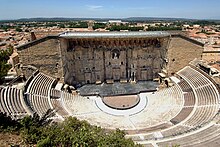Cavari
The Cavarī or Cavarēs (Gaulish: *Cauaroi, 'the heroes, champions, mighty men') were a Gallic tribe dwelling in the western part of modern Vaucluse, around the present-day cities of Avignon, Orange and Cavaillon, during the Roman period. They were at the head of a confederation of tribes that included the Tricastini, Segovellauni and Memini, and whose territory stretched further north along the Rhône Valley up to the Isère river.
Name
They are mentioned as Kaouárōn (Καουάρων) by Strabo (early 1st c. AD),[1] Cavarum by Pliny (1st c. AD),[2] Cavarum and Cavaras by Pomponius Mela (mid-1st c. AD),[3] Kaúaroi (Καύαροι) by Ptolemy (2nd c. AD),[4] and as Cavares on the Tabula Peutingeriana (5th c. AD).[5]
The ethnonym Cavarī is a latinized form of Gaulish *Cauaroi (sing. *Cauaros), meaning "the heroes", or "the mighty men".[6] It derives from the Celtic stem *kawaro-, meaning "hero, champion" (cf. Old Irish cuar "hero, champion, warrior", Middle Welsh cawr, Breton kaour "giant, champion").[7][8]
Geography
Territory
The Cavari dwelled on the east bank of the

Strabo mentioned that the lands from Cabellio (Cavaillon) up to the confluence of the Isère with the Rhône belonged to the Cavari, Pliny placed Valence in Cavarian territory, and Ptolemy located them immediately south of the Segovellauni, which indicates that they controlled, further north of their homeland, a strip of land along the Rhône up to the confluence of this river with the Isère.[12]
... if you cross the river by ferry into the city of Caballio, the whole country next thereafter belongs to the Cavari, up to the confluence of the Isar with the Rhodanus; this is also approximately where the Cemmenus Mountain joins the Rhodanus; the length of your journey from Druentia up to this place is seven hundred stadia.
— Strabo 1923. Geōgraphiká 4:1:11.
Settlements
The pre-Roman hill-fort of the Cavari was probably situated on the Colline St-Eutrope, a hill overlooking the modern town of Orange, Vaucluse.[13]

During the Roman era, their main settlement was known as
Other important settlements were located at Cabellio (
History
Early Roman period
The Cavari are not attested in historical sources before the Augustan period, and little is known about their early history.
Between 125 and 122 BC, the armies of the
The Cavari seem to have not taken part in those conflicts, and the absence of their name from the records of the Roman victories during the

Roman period
At the time of Augustus (27 BC–14 AD), the Cavari were at the head of a confederation stretching between the Durance and the Isère river, and which included the Memini, Tricastini and Segovellauni.[12][21] They were also in control of the area located around Avennio, on the eastern bank of the Rhône, which had previously belonged to the Volcae and Massalia.[16] In the early 1st century AD, Greek geographer Strabo described them as mostly, though apparently recently, Romanized:
... the Cavari stretching along parallel to [the Volcae] on the opposite side of the river, the name of the Cavari prevails, and people are already calling by that name all the barbarians in that part of the country—no, they are no longer barbarians, but are, for the most part, transformed to the type of the Romans, both in their speech and in their modes of living, and some of them in their civic life as well.
— Strabo 1923. Geōgraphiká 4:1:12.
Archaeology
The
References
- ^ Strabo. Geōgraphiká, 4:1:11, 4:1:12.
- ^ Pliny. Naturalis Historia, 3:34, 3:36.
- ^ Pomponius Mela. De situ orbis, 2:5:75, 2:5:79.
- ^ Ptolemy. Geōgraphikḕ Hyphḗgēsis, 2:9:8.
- ^ Falileyev 2010, s.v. Cavares, Col. Arausio and Avennio.
- ^ de Hoz 2005, p. 179.
- ^ Delamarre 2003, p. 112.
- ^ Matasović 2009, p. 196.
- ^ a b c Kruta 2000, p. 527.
- ^ Talbert 2000, Map 15: Arelate-Massalia, Map 17: Lugdunum.
- ^ Rivet 1988, p. 268.
- ^ a b Barruol 1969, pp. 231–241.
- ^ a b Rivet 1988, pp. 272–273.
- ^ Mladenović 2012.
- ^ Rivet 1988, p. 265.
- ^ a b c Leveau 2000, p. 40–41.
- ^ a b Rivet 1988, p. 42.
- ^ Rivet 1988, pp. 262–265.
- ^ Rawlings 2017.
- ^ Rivet 1988, p. 272.
- ^ Rivet 1988, pp. 16, 300.
Primary sources
- ISBN 9780674993648.
- ISBN 978-0674990562.
Bibliography
- OCLC 3279201.
- ISBN 978-8478825721.
- ISBN 9782877723695.
- Falileyev, Alexander (2010). Dictionary of Continental Celtic Place-names: A Celtic Companion to the Barrington Atlas of the Greek and Roman World. CMCS. ISBN 978-0955718236.
- ISBN 2-221-05690-6.
- .
- ISBN 9789004173361.
- Mladenović, Dragana (2012). "Arausio". In Bagnall, Roger S. (ed.). The Encyclopedia of Ancient History. John Wiley & Sons. ISBN 978-1-4443-3838-6.
- Rawlings, Louis (2017). "The Roman Conquest of Southern Gaul, 125-121 BC". In Whitby, Michael; Sidebottom, Harry (eds.). The Encyclopedia of Ancient Battles. John Wiley & Sons. pp. 1–7. ISBN 978-1-4051-8645-2.
- ISBN 978-0-7134-5860-2.
- ISBN 978-0691031699.

